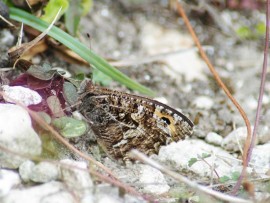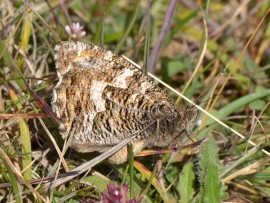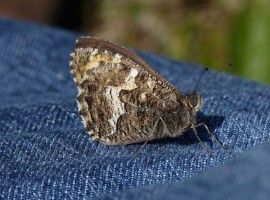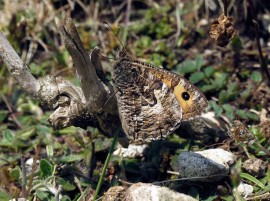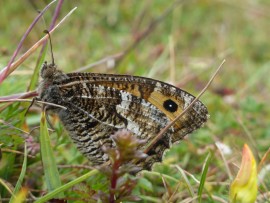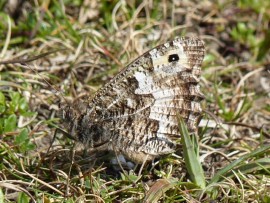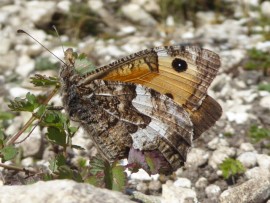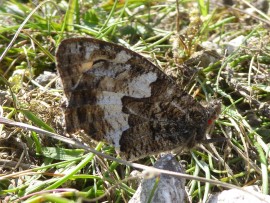by Martin Kalaher
The Grayling is an interesting butterfly species whose physiology is very well adapted to inhabiting warm micro-habitats. With 'global warming' one might suppose that an insect species 'that likes it hot' should be doing well, but on the contrary, in this county it finds itself in a parlous state, possibly facing local extinction. If we look at the distribution map for the 1990-1994 atlas Grayling was found in 15 tetrads, mostly concentrated on downland north of Eastbourne but with a scattering of colonies along the South Downs. In the 2010-2014 survey this figure plummeted to just four tetrads; three in the Wilmington area and one in the far north-west of the county at Weavers Down, near Rake. In 2016, it was found in just a single tetrad at Windover Hill, Wilmington and nowhere else. In 20-25 years it has been lost from Birling Gap, Lullington Heath NNR, Blackcap Hill, Offham, Wolstonbury Hill, Newtimber Hill, Fulking, Graffham, Levin Down and Harting Down. What has gone wrong?
In Sussex there have always been two distinct races of Grayling, one associated with chalk grassland and the other with acid heathland. They live in well-defined breeding sites where the soil is poor and thin and where there is little vegetation and plenty of bare patches. These areas of broken terrain and bare soil are vital if a Grayling colony is to flourish, and this ideal habitat is not usually created by human disturbance but by grazing animals on heathland and rabbits on calcareous grassland.
Our Sussex heathlands have been in a state of benign neglect for many decades. If Graylings are to thrive on our heaths then active management is required, which means re-creating the activity of a bygone era, that is rotational burning in the winter and grazing in the summer. It is these two interventions that create areas of bare soil, which is vital for this species. Times-are-a-changing for the better as there is an ambitious project called "Heathlands Reunited" which has been initiated by The South Downs National Park Authority. This aims to restore and re-connect heathland habitat between Woolmer Forest in Hampshire and Pulborough in West Sussex. It is a daunting task but if it proves successful then there is the possibility that natural re-colonisation of our heathlands may occur through the transient colonisers that are sometimes seen at Weavers Down.
Unfortunately, the situation on chalk grassland is no better with only one surviving colony at Windover Hill, Wilmington. Grayling are mainly found in Deep Dean although in better years they can also be located in Ewe Dean. In the past few years the occasional butterfly has strayed eastwards towards Folkington Hill and low numbers have also been seen at Litlington White Horse at High and Over. Sadly, these exploratory forays by a few individuals never seem to come to much and in 2016 Grayling was confined to a single tetrad, in the whole of Sussex. Adding to this concern was a recent observation that some of the bare patches, where Grayling had previously been located in Deep Dean, were now grassing over. The national rabbit population is currently under attack by two different strains of haemorrhagic disease as well as myxomatosis (which has waxed and waned over the past 60+ years). A sustained reduction in the rabbit population at Deep Dean would very worrying.
-7378898723.jpg)
Bob Eade
When surveying Grayling colonies it is generally the males that are located on their territorial perches. After feeding briefly, early in the morning, they disperse to their territories, usually perching on lichen initially but then on to a bare patch of baked earth or rock. They remain on territory for most of the day waiting for a female to fly past, but intercepting more-or-less any moving object to ensure there is no missed opportunity. Should it be a female she soon alights and the male lands behind her, before walking around so that the two are face-to-face, after which there follows an elaborate, charming courtship.
In warm weather the female lays eggs throughout the day, generally on a small tuft of young grass growing in a sheltered, sunny pocket of bare ground. Sheep's Fescue is the preferred larval food plant on chalk whilst Bristle Bent is favoured on heaths. In his studies on Dartmoor, Professor Thomas (BoB&I) found that where the eggs were laid, the ground temperatures reached as high as 40 degrees centigrade. The eggs hatch after 10-20 days and the caterpillars immediately begin feeding on the tender tips of their larval food plant. They moult twice before hibernating in a small tussock of grass and then resume feeding in the following spring. They moult twice more before attaining full growth in mid-June. These larger caterpillars only feed at night but intrepid explorers such as Michael Blencoe (current species champion) is well-known for finding them by torchlight! After a total of four moults the chrysalis is formed in a silk-lined cell, hidden just below the surface of the soil.
Both the caterpillar and the chrysalis are very well camouflaged, but the truth is that most of us will probably never look for them. However, we might be tempted to undergo a pilgrimage to Windover Hill and look for the adults, but they too can be astonishingly difficult to spot. With the wings closed so that the eye-spots are hidden they can blend imperceptibly into the background. On the ground with wings tightly closed they can look quite small but the Grayling is our largest brown and in flight it is very impressive, both soaring and swooping at high speed when it appears more like a vanessid than a brown.
Both sexes spend a great deal of time regulating their temperature. Swedish studies have shown that captive females lived the longest and laid the most eggs if the ambient temperature was kept at 30 degrees centigrade. Sites such as Windover Hill can be "baking hot" one moment and quite cool the next so this species has evolved ways of keeping its body temperature a steady 32 degrees C. In cool weather the butterfly leans at an angle, sideways on, in order to expose the maximum area of wing and body towards the sun, whilst in hot weather in stands on tiptoe with its head facing the sun, thus minimising its exposure to the sun's rays.
From a dozen or more colonies 20-25 years ago to just a single colony confined to one tetrad at Windover Hill is by any standards a calamitous decline. It would be an enormous shame to lose this interesting butterfly, but experience tells us that when a species is reduced to a single colony it is likely to have an uncertain future.
The only reliable area in which to find the Grayling is around Windover Hill. The main colony is found within Deep Dean TQ544031, but the species can also be located around the Ewe Dean reservoir TQ537034 in some years.



